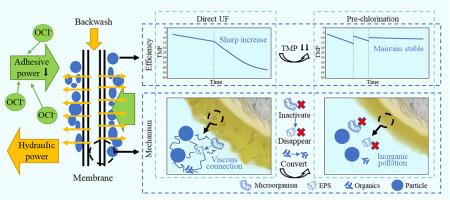预氯化对直接处理季节性高湍流地表水的超滤工艺的影响:膜结垢控制和抗冲击负荷
IF 6.3
2区 工程技术
Q1 ENGINEERING, CHEMICAL
引用次数: 0
摘要
由于膜严重堵塞,地表水中季节性的高浊度给直接超滤(UF)的可行性带来了巨大挑战。本研究采用直接超滤工艺处理高浊度地表水。在传统的操作规程下,会出现严重的膜污垢。模型拟合表明,高浊度水超滤产生的膜污垢主要与膜表面的孔隙完全阻塞以及随后形成的滤饼层有关。本研究开发了一种使用次氯酸钠的预消毒工艺,在长期(885 小时)过滤过程中,膜堵塞现象明显减轻。在处理 800 NTU 地表水时,优化氯剂量为 1.5 mg/L,使超滤过程的跨膜压力(TMP)稳定在较低水平(10 kpa)。预消毒可有效灭活微生物,减少微生物胞外聚合物物质(EPS)的存在。这样,滤饼层上由高浊度水造成的复杂粘性污垢就会转变为无机污垢。通过预氯化,附着在膜上的滤饼层的粘附力大大降低,使污垢更容易脱离,并在水力反冲洗造成的剪切应力作用下从膜表面清除。这些发现有望为直接处理季节性高湍流地表水的超滤膜污垢控制提供新的见解。本文章由计算机程序翻译,如有差异,请以英文原文为准。

Effects of pre-chlorination on ultrafiltration process in directly treating seasonal high-turbidity surface water: Membrane fouling control and shock load resisting
The seasonal high turbidity in the surface water is posing great challenges to the feasibility of direct ultrafiltration (UF) due to the severe membrane fouling. In this study, a direct UF process was employed to treat the high-turbidity surface water. With the conventional operational protocols, severe membrane fouling encountered. Model fitting indicated that membrane fouling, resulting from the UF of high turbidity water, was predominantly associated with the complete obstruction of pores on the surface of the membrane and the subsequent formation of a cake layer. A pre-disinfection process using sodium hypochlorite was developed in this study, and the membrane fouling was significantly mitigated during long-term (885 h) filtration. The optimized chlorine dosage was 1.5 mg/L in treating the 800 NTU surface water, and enabled the transmembrane pressure (TMP) stabilization of UF process at a low level (<10 kpa). Pre-disinfection can effectively inactivate microorganisms and diminish the presence of microbial extracellular polymeric substances (EPS). This results in a transition from complex and viscous fouling to inorganic fouling on the cake layer caused by high turbidity water. With pre-chlorination, the adhesion force of the cake layer attached on the membrane reduced significantly to make the fouling more easily detach and be removed from on the membrane surface by the shear stress caused by the hydraulic backwash. These findings are expected to develop new insights into the membrane fouling control of UF in directly treating the seasonal high-turbidity surface water.
求助全文
通过发布文献求助,成功后即可免费获取论文全文。
去求助
来源期刊

Journal of water process engineering
Biochemistry, Genetics and Molecular Biology-Biotechnology
CiteScore
10.70
自引率
8.60%
发文量
846
审稿时长
24 days
期刊介绍:
The Journal of Water Process Engineering aims to publish refereed, high-quality research papers with significant novelty and impact in all areas of the engineering of water and wastewater processing . Papers on advanced and novel treatment processes and technologies are particularly welcome. The Journal considers papers in areas such as nanotechnology and biotechnology applications in water, novel oxidation and separation processes, membrane processes (except those for desalination) , catalytic processes for the removal of water contaminants, sustainable processes, water reuse and recycling, water use and wastewater minimization, integrated/hybrid technology, process modeling of water treatment and novel treatment processes. Submissions on the subject of adsorbents, including standard measurements of adsorption kinetics and equilibrium will only be considered if there is a genuine case for novelty and contribution, for example highly novel, sustainable adsorbents and their use: papers on activated carbon-type materials derived from natural matter, or surfactant-modified clays and related minerals, would not fulfil this criterion. The Journal particularly welcomes contributions involving environmentally, economically and socially sustainable technology for water treatment, including those which are energy-efficient, with minimal or no chemical consumption, and capable of water recycling and reuse that minimizes the direct disposal of wastewater to the aquatic environment. Papers that describe novel ideas for solving issues related to water quality and availability are also welcome, as are those that show the transfer of techniques from other disciplines. The Journal will consider papers dealing with processes for various water matrices including drinking water (except desalination), domestic, urban and industrial wastewaters, in addition to their residues. It is expected that the journal will be of particular relevance to chemical and process engineers working in the field. The Journal welcomes Full Text papers, Short Communications, State-of-the-Art Reviews and Letters to Editors and Case Studies
 求助内容:
求助内容: 应助结果提醒方式:
应助结果提醒方式:


